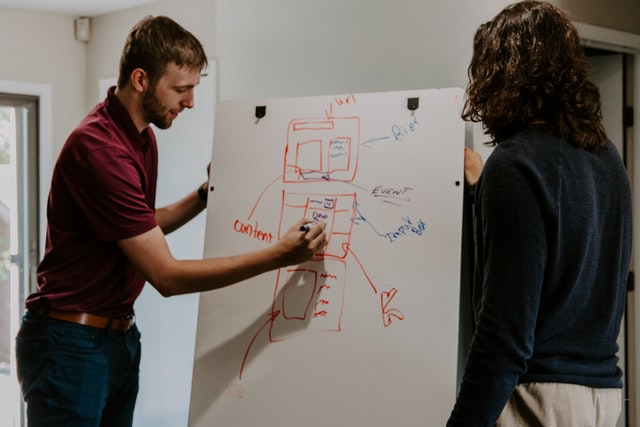Collaboration Problems in the Workplace (and how to solve them)
Collaboration in the workplace is more critical than ever before to the success fo your business. When two or more members of a team work together in order to accomplish a common goal, the results are usually better than what any one person could achieve alone.
In the digital age and with the rise of distributed workforces, collaboration has taken on new levels of importance, and often faces new challenges as well. Without the proper tools for real-time communication, collaboration with your teammates can break down and leave all parties feeling frustrated.
In today's article, I'll share four of the most common collaboration problems in today's workplace, and share tips to solve these problems.
Let's get started.
Wrong Mindset

Collaboration Problem #1: Having the Wrong Mindset
Having the wrong mindset can easily be the root of all other problems when it comes to collaborating with others in the workplace.
A common misconception when it comes to group activities is that the leader carries the entire project as other members of the group fall back. If you have experienced this first hand, then that could be why collaboration intimidates you.
Having the wrong mindset when collaborating could lead you to do very little, or do everything because that is what you predict the outcome will be from the beginning.
The Solution
The key thing to remember is mind over matter. Entering the situation with an open mind and really listening to what others have to say and actively sharing your ideas will open doors that lead to improved planning, and effective communication among your teammates.
This will help to create a positive working environment where collaboration is fun and valuable.
Miscommunication

Collaboration Problem #2: Miscommunications
Even with the right mindset, there can still be miscommunications when collaborating with your team. This is especially true if tasks are delegated online.
An email that you thought you sent, a typo in a message, and unclear instructions are all causes of miscommunication that can derail your entire project.
Your Solutions
- The first and most important thing to remember in effective communication is language. Regardless of whether you are communicating in person or online you will want to be mindful of your language so that it is clear and concise. This will help to prevent miscommunications and ensure everyone is on the same page. Repeat yourself often and don’t be afraid to ask questions and even correct yourself when it makes sense to do so.
- Communication tools are readily available on our mobile devices. Before you hit send on a message, be sure that you're observing proper grammar ... misplacing a comma or period can change the entire nature of a message. You will want to also observe proper netiquette, remember that tone is not easily conveyed over messages. Typing in all capital letters is considered yelling, and slang is not universally understood across different generations.
- Set boundaries. While communication platforms are available to use 24/7, that does not mean that you should send messages at all hours of the day. Sometimes sending a message asking for more work at 9pm can send the wrong message and make someone feel they aren't working hard enough. Separate and distinguish your working hours from your home hours. Designate a time with your team members wherein everybody should be online at the same time to discuss matters related to the project.
Workload and Delegation

Collaboration Problem #3: Mismanaging Workload / Not Delegating
More hands on deck does not necessarily mean that there is less work left to do. Nor does assigning take home projects means that your team work will have faster turnaround times on tasks.
Remember, like all projects, tasks need to be divided in an appropriate manner so that team members do not feel overwhelmed and burned out.
Solutions to This Problem
- Plan ahead. Explicitly layout what needs to be done, by whom, and when tasks should be completed. Do this ahead of time so that members will be able to plan and adjust accordingly.
- Provide flexibility. In a perfect world, there would be no delays, but you will want to give extra time in order to go over and review mistakes or for late submissions due to unplanned circumstances.
- Make use of calendar and planning apps like Google Calendar in order to properly delegate tasks and provide an accurate timeline of project schedule.
Bottlenecks

Collaboration Problem #4: Running Into Bottlenecks
In project management, a bottleneck refers to the limit of movement in a project that ultimately pushes the project back.
This happens when all tasks have been completed and submitted but are being held up by the last check. In many cases this could be the pending approval period, and a lack of efficiency in this area can cause a bottleneck and slow down the entire prject.
Solution to This Problem
Ultimately, the solution to this collaboration problem lies within time management and task delegation.
Do not leave the final approval to one person. Divide and break up tasks even more so you get the most out of your team.
For example, if four members are assigned different tasks at the same time, do not leave one person to check their work and add finishing touches. This slows down the process as one person is left with a heavier workload.
Make the task ratios proportionate to avoid bottlenecks in your workflow.
Related: 3 G Suite Workflow Tips to Help Your Business Grow
How the Right Collaboration Tools Can Help Solve Problems

The best way to enjoy a smooth collaboration experience in the workplace is to optimize your resources and use the right tools for the right jobs.
Not only are there channels such as email, video conferencing, and instant messaging, but there are also a variety of cloud based platforms that allow you to collaborate with your team members in real time.
Here are a few of our favorite tools to help avoid collaboration problems for distributed teams and remote workers:
Chat Applications
Chat and instant messaging apps are a great way to get the most out of team communication. They allow you to separate work conversations from personal ones by using a completely different platform.
Google Hangouts, Slack, and Viber are some of my favorites.
Conference Calls
Working from home is part of the new normal, and video conferencing has emerged as one of the best ways to communicate with your teammates.
There is less room for miscommunication with voice and video chats and they can even be recorded so there’s no need to take down minutes.
Great platforms for conference calls include platforms such as Google Meet, Zoom, and a number of competitors.
You can use each of these platforms and their basic features for free with different restrictions or you can upgrade to get full benefits at different pricing plans. Google Meet is free temporarily due to the pandemic. Contact us if you'd like a full-featured set-up at your business!
Collaborative Real-Time Editing
What’s a better way to collaborate than working together in real time?
With cloud-based productivity apps such as Google Docs, Sheets, and Slides, you can easily share work and collaborate with comments while editing a project together in real time.
Planning Apps
An important part of any project is planning.
With the right tools, your planning apps can easily integrate with other applications. Planning tools such as Google Calendar, Outlook Calendar, and Trello will help you visually lay out what needs to be done, see member availability, and separate finished tasks from ongoing ones.
Cloud Storage
Need a secure place to store your work where your teammates can still access?
Cloud based programs such as Google Drive and DropBox are popular choices for businesses.
Secure cloud storage provides a way you can store your data, free up storage in your personal devices and allow access to your teammates.
Google Drive allows up to 15gb of free storage and DropBox offers a free trial. With 5 or more G Suite Business or Enterprise licenses your entire team will enjoy unlimited secure cloud storage - the best value you'll find anywhere.
Other Cloud-Based Collaborative Applications
If your project is longer, or if your team frequently uses collaboration tools, a great option would be to invest in an all around suite of cloud-based collaborative tools and productivity apps. This way you can leverage the full benefits of multiple tools in one pricing package.
A great option is G Suite by Google.
G Suite offers all the Google tools mentioned above, with their full benefits, at low and affordable pricing packages. You'll also enjoy benefits such as unlimited data, administrative controls, improved integrations, and much more.
Final Thoughts About Solving Collaboration Problems at Work

We need to collaborate, and having the right tools to reduce common collaboration problems is more important now than it ever has been in our history.
Whether your project takes one week or six, needs two people or ten, there are a variety of simple solutions and tools available to help you get your project to the finish line by working well together.





.png)
